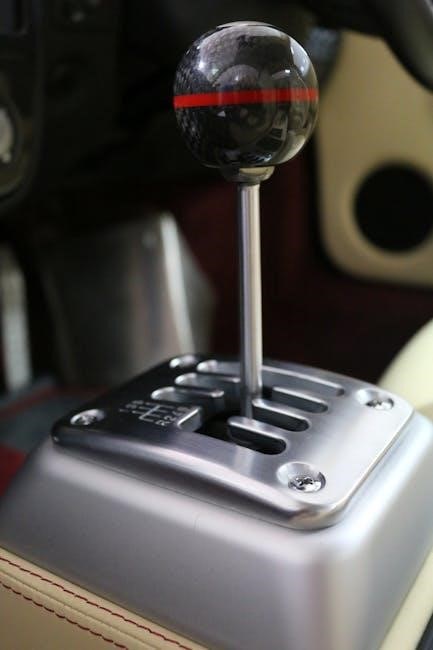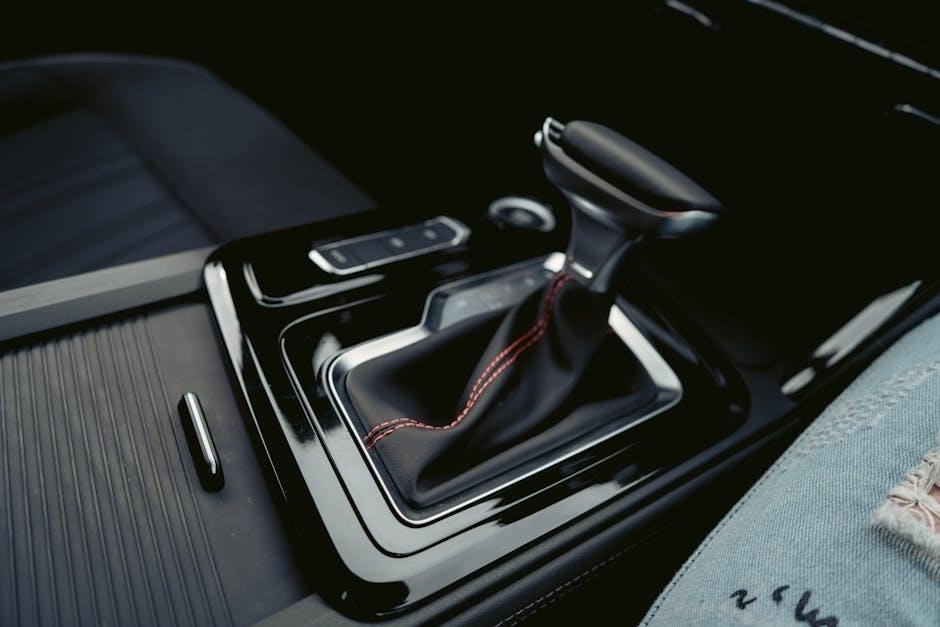In the automotive industry, transmissions play a pivotal role in enhancing driving experiences. Manual and automatic transmissions offer distinct advantages, catering to different preferences and driving conditions. Understanding their mechanisms and benefits is crucial for making informed decisions, whether prioritizing fuel efficiency, performance, or convenience.

Manual Transmission
A manual transmission requires the driver to engage the clutch and shift gears, offering better fuel efficiency and control over performance, especially in specific driving conditions.
How Manual Transmissions Work
A manual transmission operates by using a clutch pedal and a gearshift to manually change gears. The driver presses the clutch pedal to disconnect the engine from the transmission, allowing the gearshift to select the desired gear. Once the gear is engaged, the driver releases the clutch pedal slowly to reconnect the engine with the transmission. This process requires coordination between the clutch and accelerator pedals, enabling smooth gear transitions. Manual transmissions rely on the driver’s skill to match engine speed with the appropriate gear for optimal performance and efficiency.
Advantages of Manual Transmissions
Manual transmissions offer several benefits, including better fuel efficiency and lower costs. They are typically lighter and simpler in design, reducing overall vehicle weight and improving mileage. Drivers also experience greater control over gear shifts, enabling optimal acceleration and performance. Additionally, manual transmissions are generally more reliable and require less maintenance than automatics. They provide a more engaging driving experience, appealing to enthusiasts who enjoy precise control. Furthermore, manual transmissions often cost less to purchase upfront and repair, making them a cost-effective choice for many drivers.
Disadvantages of Manual Transmissions
Manual transmissions require more driver effort, as they need constant engagement with the clutch and gearshift, especially in heavy traffic. This can be tiring on long drives. Additionally, mastering a manual transmission takes time and practice, which can be a challenge for new drivers. Manual transmissions may also struggle in hilly or stop-and-go traffic, where frequent shifting is necessary. Furthermore, they are less convenient in urban driving conditions compared to automatics. While manuals offer better control, the constant need for manual shifting can be a drawback for those seeking a more relaxed driving experience.

Automatic Transmission
Automatic transmissions provide effortless gear shifting through a torque converter, offering unparalleled convenience and ease, particularly beneficial in heavy traffic and urban driving scenarios for drivers.
How Automatic Transmissions Work
Automatic transmissions utilize a torque converter to connect and disconnect the engine from the transmission, eliminating the need for manual clutch operation. The system employs planetary gear sets and sensors to monitor driving conditions like speed and throttle input. Hydraulic controls, guided by electronic signals, activate clutches and bands to engage the appropriate gear ratio seamlessly. This process ensures smooth acceleration and effortless gear shifting without driver intervention, providing a convenient and stress-free driving experience in various conditions, from city traffic to highway cruising.
Advantages of Automatic Transmissions
Automatic transmissions offer unparalleled convenience and ease of use, especially in stop-and-go traffic. They eliminate the need for manual gear shifting, reducing driver fatigue and allowing for a more relaxed driving experience. Smooth acceleration and seamless gear transitions ensure optimal comfort, making them ideal for urban environments. Additionally, automatics are often easier to handle for inexperienced drivers, as they do not require clutch coordination. Many modern automatic transmissions also feature advanced technologies like adaptive shifting, which tailors gear changes to driving conditions, enhancing both performance and fuel efficiency. This combination of simplicity, comfort, and adaptability makes automatic transmissions a popular choice for everyday driving.
Disadvantages of Automatic Transmissions
Automatic transmissions are generally more expensive to purchase and maintain compared to manual transmissions. They are also heavier, which can reduce fuel efficiency and performance. The added complexity of automatic transmissions increases the likelihood of mechanical issues, leading to higher repair costs. Additionally, automatics often lack the driver engagement and control that manual transmissions provide, which can be a disadvantage for driving enthusiasts. While modern automatics have improved significantly, they still tend to be less fuel-efficient than manuals in many cases, especially in city driving conditions. These factors make automatic transmissions less appealing for budget-conscious buyers or those prioritizing efficiency and driver involvement.

Comparison Between Manual and Automatic
Manual transmissions offer better fuel efficiency and lower costs, while automatics provide ease of use, especially in traffic. Dual-clutch transmissions bridge both worlds, combining efficiency and convenience seamlessly.
Driving Experience
Manual transmissions deliver a more engaging driving experience, offering precise control and a direct connection to the vehicle, which appeals to driving enthusiasts. They provide better fuel efficiency and cost less to maintain. Automatic transmissions, however, prioritize convenience, especially in heavy traffic, with smooth and seamless gear shifts. Dual-clutch transmissions (DCTs) combine the best of both worlds, offering quick and efficient gear changes while maintaining the efficiency of manual transmissions. Despite their complexity and higher cost, DCTs provide a balanced option for drivers seeking both performance and ease of use.
Fuel Efficiency
Manual transmissions are generally more fuel-efficient than automatics, especially in city driving, as they allow drivers to optimize gear shifts for better mileage. Automatic transmissions, while convenient, often consume more fuel due to the torque converter. However, advancements in dual-clutch transmissions (DCTs) have bridged this gap, offering fuel efficiency comparable to manuals while providing the convenience of automatic shifting. DCTs achieve this by pre-loading the next gear, reducing shift times, and minimizing power loss during gear changes, making them a popular choice for drivers seeking both performance and economy.
Cost
Manual transmissions are typically more affordable to purchase and maintain compared to automatics. They have fewer components, reducing production costs and repair expenses. Automatic transmissions, especially modern dual-clutch variants, are more complex and expensive to produce and service. However, the convenience of automatics often justifies the higher cost for many drivers. Over time, manual transmissions may save money through lower maintenance and fuel costs, while automatics might offer better resale value in certain markets. Balancing initial purchase price, maintenance, and long-term savings is key to deciding which transmission type aligns with your budget and driving habits.

Dual-Clutch Transmission (DCT): A Hybrid Option
Dual-clutch transmissions combine manual and automatic features, using two clutches for odd and even gears, enabling fast, smooth shifts, and blending performance with efficiency seamlessly.
How DCT Works
A dual-clutch transmission (DCT) operates by using two clutches to manage odd and even gear sets. One clutch engages the current gear while the other pre-selects the next, enabling rapid shifts without interrupting power delivery. Controlled by advanced electronics and hydraulics, DCTs eliminate the need for a torque converter, combining the efficiency of manual transmissions with automatic convenience. This system allows for quick, smooth transitions between gears, enhancing both performance and fuel efficiency, and can function in fully automated or manual modes, offering drivers flexibility and seamless driving experiences.
Advantages of DCT
Dual-clutch transmissions (DCTs) offer faster and smoother gear shifts compared to traditional automatics, enhancing both performance and efficiency. They provide better fuel economy than conventional automatic transmissions while maintaining the responsiveness of manual gearboxes. DCTs eliminate the need for a torque converter, reducing weight and improving acceleration. Drivers can enjoy either fully automated operation or manual control, offering flexibility. The seamless transitions between gears minimize power loss, making DCTs ideal for high-performance vehicles. Additionally, they are lightweight and compact, contributing to overall vehicle efficiency. These benefits make DCTs a preferred choice for drivers seeking a balance between performance, convenience, and fuel efficiency.
Disadvantages of DCT
Dual-clutch transmissions (DCTs) are complex and expensive to produce, making them less accessible to budget-conscious buyers. They can exhibit rough low-speed driving behavior, such as jerky takeoffs or hesitation, which may frustrate city drivers. Additionally, DCTs require sophisticated electronics and hydraulics, increasing the risk of mechanical issues if not properly maintained. Their reliability can vary depending on the manufacturer, with some models experiencing faulty sensors or software glitches. Furthermore, DCTs are heavier than manual transmissions and may not offer significant fuel economy improvements in all driving conditions. Their higher cost and potential for repair complications make them less practical for some drivers.